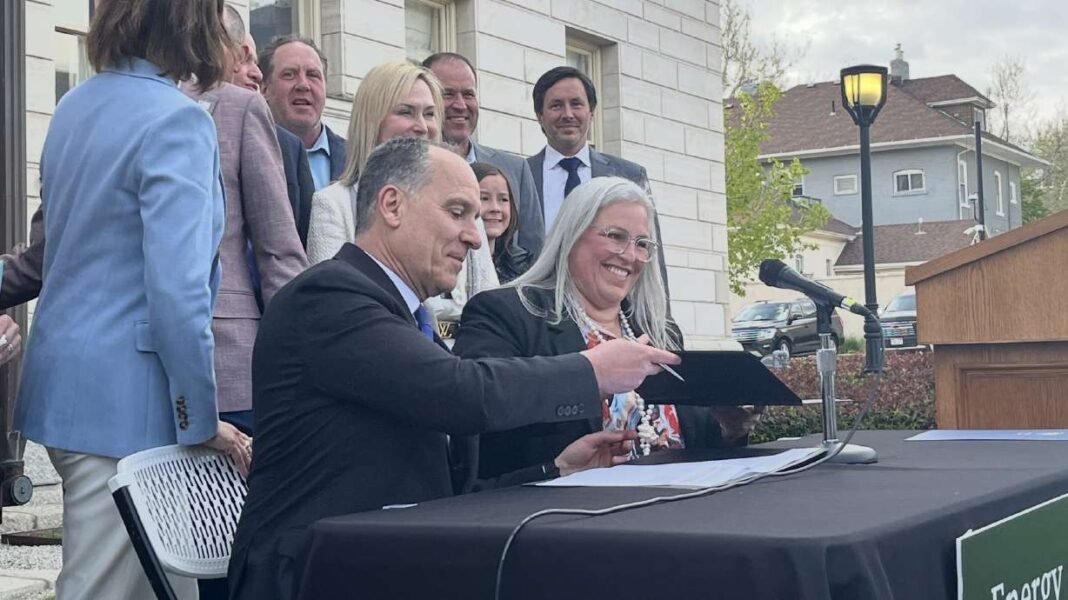SALT LAKE CITY — Utah is looking to go nuclear as it takes the next step since launching Operation Gigawatt, a program seeking to double its statewide energy output over the next decade.
After ceremonially signing a few energy-related bills outside of the Governor’s Mansion Monday evening, Utah Gov. Spencer Cox gave up his seat to allow for Emy Lesofski, director of the Utah Office of Energy Development, and John C. Wagner, director of Idaho National Laboratory, to sign a memorandum of understanding, speeding up Utah’s involvement in nuclear research.
The agreement allows for a “structural, interdisciplinary alliance” between the state and the U.S. Department of Energy’s Office of Nuclear Energy. The deal paves the way for establishing the Advanced Nuclear and Energy Institute, a collaboration between the Idaho-based lab and the Utah Office of Energy Development, Utah System of Higher Education and the Utah San Rafael Energy Lab.
“I’m so excited that Utah is working with Idaho National Laboratory on such an important and timely project,” Cox said. “Utah will not be left behind in the advancement of energy development and production, and this partnership with INL will be foundational to our goals under Operation Gigawatt.”
Monday’s ceremony took place on the eve of an energy conference between Utah, Idaho and Wyoming leaders. It also comes after energy development became a key focus during this year’s legislative session.
The growth of artificial intelligence and data centers is creating an “exponential demand” for large-load electricity, Sen. Scott Sandall, R-Tremonton. The senator sponsored SB132 this year, which helps separate these loads from the traditional electricity base, keeping rates lower for residents.
State leaders have discussed the topic for years, meeting with Rocky Mountain Power and other energy providers to determine that an energy shortage may be on the horizon, added Utah House Speaker Mike Schultz, R-Hooper. That sparked a flurry of bills taken up this year.
Utah also started exploring nuclear energy as a solution to the demand. Another bill, HB249, established the Nuclear Energy Consortium and the Utah Energy Council, leading to the state’s coordination with the Idaho National Laboratory.
Turning to nuclear power caused some stir on Capitol Hill this year. Some voiced concerns about rising costs, while others pointed to examples of partial or full meltdowns as environmental risks.
“Nuclear energy is powerful. It can also be incredibly dangerous,” said Mike Maxwell, a former nuclear power generation industry expert who now volunteers for a few groups, including the Healthy Environmentment Alliance of Utah, during one of the committee meetings on the bill.
Despite its complicated past, it seems many residents are interested in Utah’s push to go nuclear. Nearly half of the 805 registered Utah voters surveyed for a Deseret News/Hinckley Institute of Politics poll earlier this year said they either strongly or somewhat support plans to build small nuclear reactors in the state, as compared to almost one-third against.
Donning a blue and yellow tie that he said was meant to represent carbon-free power and yellowcake (unranium ore), Rep. Carl Albrecht, R-Richfield, who sponsored HB249, said his bill isn’t perfect and might be “tweaked many times.”
However, he believes the high energy demands point to nuclear energy. “Eventually, we’re going to get nuclear power,” he said.
It’s also a future that could come soon. Utah-based EnergySolutions is currently working on an initiative with the state of Utah and the Intermountain Power Agency to explore nuclear reactors at a plant in Delta.
Utah’s new agreement with Idaho National Laboratory aims to help Utah “accelerate the development and deployment of next-generation nuclear technologies” while enhancing energy research, strengthening cybersecurity and physical security around energy, and building the workforce needed to handle future energy needs.
“It is really going to provide a really powerful tool for our state … to be able to further cement our status as energy leaders in the region,” Lesofski said. “It’ll also be a great tool in making Operation Gigawatt a reality.”
The Key Takeaways for this article were generated with the assistance of large language models and reviewed by our editorial team. The article, itself, is solely human-written.




